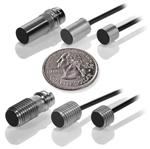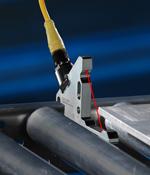- FMA
- The Fabricator
- FABTECH
- Canadian Metalworking
Categories
- Additive Manufacturing
- Aluminum Welding
- Arc Welding
- Assembly and Joining
- Automation and Robotics
- Bending and Forming
- Consumables
- Cutting and Weld Prep
- Electric Vehicles
- En Español
- Finishing
- Hydroforming
- Laser Cutting
- Laser Welding
- Machining
- Manufacturing Software
- Materials Handling
- Metals/Materials
- Oxyfuel Cutting
- Plasma Cutting
- Power Tools
- Punching and Other Holemaking
- Roll Forming
- Safety
- Sawing
- Shearing
- Shop Management
- Testing and Measuring
- Tube and Pipe Fabrication
- Tube and Pipe Production
- Waterjet Cutting
Industry Directory
Webcasts
Podcasts
FAB 40
Advertise
Subscribe
Account Login
Search
Sensors evolve to meet new errorproofing role
- By Henry Menke and Tom Draper
- September 16, 2008
- Article
- Assembly and Joining
Choosing the right sensor is one of the most important strategic decisions a world-class manufacturer makes. Sensors provide a simple means to improve the overall production process and product quality. In fact, without the right feedback from accurate sensors, strategically placed and integrated into the overall system, significant quality and throughput improvement is virtually impossible.
As the PLC-driven factory automation process has matured, the specialized hardware/generic software combination mostly has given way to generic hardware and specialized software. Concurrently the goals of the automation process have migrated as well. The object of the control suite has changed to producing perfect parts all the time. This has elevated the once lowly sensor to a key control component in the mix.
Today the sensor's role is not only to confirm a step is ready to be taken (or has been taken), but that the step has been executed correctly. Once engineers saw that it was possible to use sensors to verify quality at each step of the production process, the flood gates opened. Sensors continue to evolve, improving the quality control process and taking a key role in countless errorproofing programs geared to lowering downtime while making high-quality parts all the time.
Among the ways in which sensors are evolving are size, shape, and basic technology, all geared to minimizing installation and mounting issues, maintenance, and configuration roadblocks. Following are some examples of today's sensors.
Minisensors
For maximum effectiveness, sensors often have to be placed in hard-to-install places, where there is just no room for conventional designs. To meet this challenge, sensor makers have been decreasing their size (Figure 1)—3-mm-diameter smooth case styles and 4-mm threaded versions are commonly available.
Even smaller, ultrashort sensors designed for installing in extremely cramped places are being introduced. These short inductive proximity sensors are opening up new frontiers for machine designers. Intended primarily for OEM applications, these sensors will help fuel the drive toward more compact machinery. Their extremely low mass enables abrupt acceleration and deceleration on highly dynamic, fast-moving equipment without adding excessive inertial load.
These minisensors are designed specifically for high-speed pick-and-place equipment, miniature grippers, linear slides, miniature valves, compact actuators, and most other highly compact, precision mechanisms. Prewired cable models are now available in lengths as short as 6 mm, while connectable models are only 18 mm long. All have a nominal 1.5-mm sensing range.
Minisensors have such small dimensions and low mass that they can be placed directly into a gripper finger without adversely affecting the gripper finger's size or weight. Moreover, they can survive in industrial processes such as stamping operations, where shock, vibration, and liquid or particulate contamination would quickly take optical sensors out of action. What is also unique is that their amplifiers are located inside the sensor bodies.
Self-contained Photoelectric Through-beam Sensors
A newer sensor, the self-contained through-beam, sometimes called a fork sensor, is changing the way to approach photoelectric sensors. The through-beam sensor combines the precision of a photoelectric sensor with the robustness of an inductive.
This sensor style, typically configured in a block letter C (Figure 2) or L (Figure 3) shape, sends a beam of light, either visible red or laser, from one arm of the sensor to the other. Self-contained through-beams are configured in various ways, from narrow gap to wide versions up to about 8 in.

Figure 2Click image to view larger C-style through-beam photoelectric sensor monitors spark plug boot feed on conveyor
The through-beam-style sensors have high accuracy with their visible red LED emission and self-contained electronics. Laser versions are capable of resolutions down to 0.03 mm.
Among the through-beam sensor's attributes are:
- Highly visible red emission for easy setup
- Rugged, rigid, single-piece metal housing for stable, accurate readings over long periods of production time
- High-resolution capability that can sense very small parts or very small part variation
- High switching frequency to handle rapid production rates
Counting, checking configuration, and verifying product position are some of the tasks that can be accomplished by through-beam sensors. Applications include:
- Tool break monitoring
- Position verification
- Feed verification on automatic assembly equipment
- Part ejection verification
- Double-hit elimination in stamping
- Parts sensing on feed lines and conveyor belts (down to 0.3 mm in size with visible red; 0.03 mm using laser versions)
- Parts dimension verification (down to 0.2-mm repeatability with visible red; 0.01-mm repeatability with laser versions)
- Parts counting on assembly lines
Self-contained through-beam sensors are quickly emerging as jacks-of-all-trades, and masters of some applications.
The Optical Sensor Emerges
The next step forward in sensor-driven product quality improvement is the merger between sensor and vision systems. Sensor suppliers are now providing more sophisticated sensors advancing up the curve towards vision. Meanwhile vision providers are trying to expand down the curve toward the discrete sensor world. But instead of a crash of technologies, a new layer of technology is evolving that combines the best from each.
Enter optical sensors (Figure 4). This new category of sensor bridges the gap between the two technologies by providing a way to errorproof production by simultaneously checking several aspects of the product with a single device. An optical sensor using simplified configuration interfaces and multiple inspection/measurement algorithms driving multiple sensing options can provide more information than a single-function "smart camera" or a standard discrete sensor. It can be less complex and less costly than a vision system, while providing the desired accuracy.
This new technology is more like a smart sensor than a vision system. Just like a sensor, it is configured to look for certain attributes of a part or product to make sure specific aspects of the product are present, the part is configured correctly, and positioning is verified. But unlike a discrete sensor, because it is an optical sensor, it does not need the part to be presented exactly the same way for each inspection, thus reducing fixturing costs.
Unlike a discrete sensor, the optical sensor can check for multiple characteristics at the same time. It takes the place of several sensors, each of which can check only one thing at a time. Optical sensor technology is designed to reduce downtime, simplify line changeovers, and accommodate flexible or build-to-suit manufacturing.
Sensor manufacturers constantly are pushing the envelope to deliver the means for their customers to increase production rates, reduce costs, and provide 100 percent in-spec products and parts. As they do, their customers are better able to make a profit while competing with low-labor-rate competition from overseas. For today's times, that's the name of the game.
Henry Menke is object detection products manager and Tom Draper is manager of marketing programs at Balluff, www.balluff.com, 8125 Holton Drive, Florence, KY 41042. Draper can be reached at 800-543-8390, tom.draper@balluff.com.
Related Companies
subscribe now

The Fabricator is North America's leading magazine for the metal forming and fabricating industry. The magazine delivers the news, technical articles, and case histories that enable fabricators to do their jobs more efficiently. The Fabricator has served the industry since 1970.
start your free subscription- Stay connected from anywhere

Easily access valuable industry resources now with full access to the digital edition of The Fabricator.

Easily access valuable industry resources now with full access to the digital edition of The Welder.

Easily access valuable industry resources now with full access to the digital edition of The Tube and Pipe Journal.
- Podcasting
- Podcast:
- The Fabricator Podcast
- Published:
- 04/16/2024
- Running Time:
- 63:29
In this episode of The Fabricator Podcast, Caleb Chamberlain, co-founder and CEO of OSH Cut, discusses his company’s...
- Industry Events
16th Annual Safety Conference
- April 30 - May 1, 2024
- Elgin,
Pipe and Tube Conference
- May 21 - 22, 2024
- Omaha, NE
World-Class Roll Forming Workshop
- June 5 - 6, 2024
- Louisville, KY
Advanced Laser Application Workshop
- June 25 - 27, 2024
- Novi, MI

































